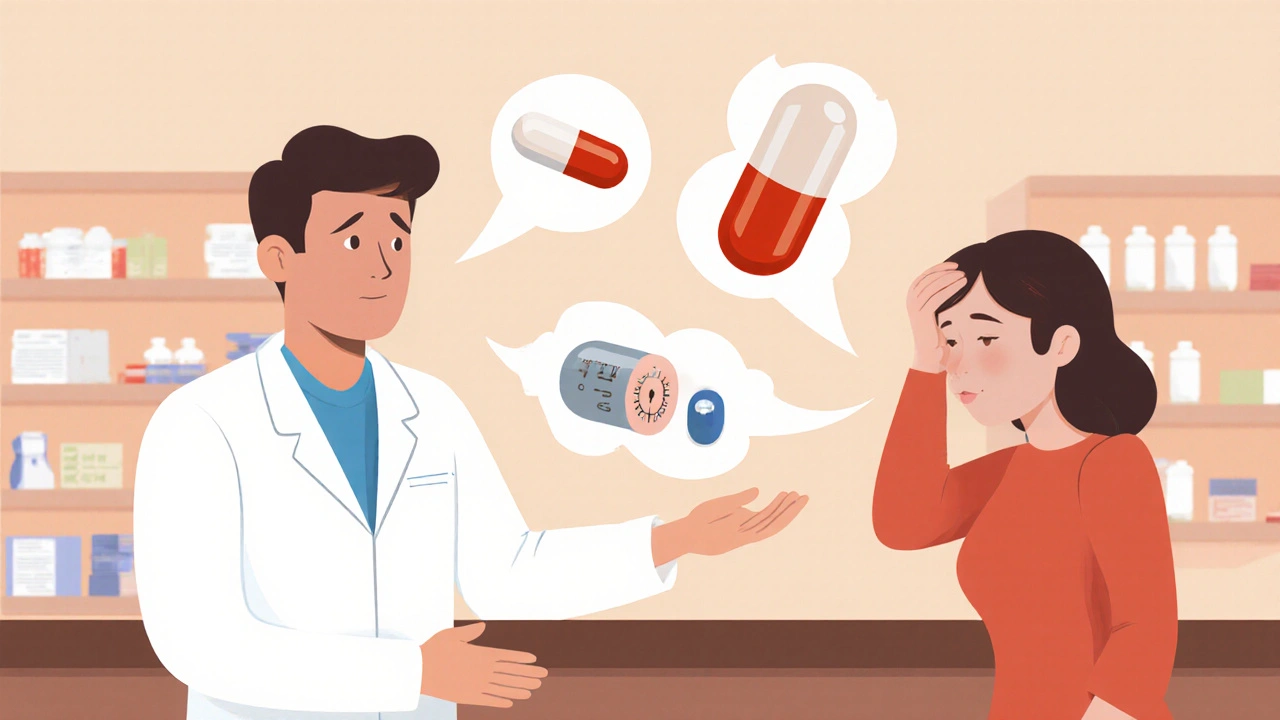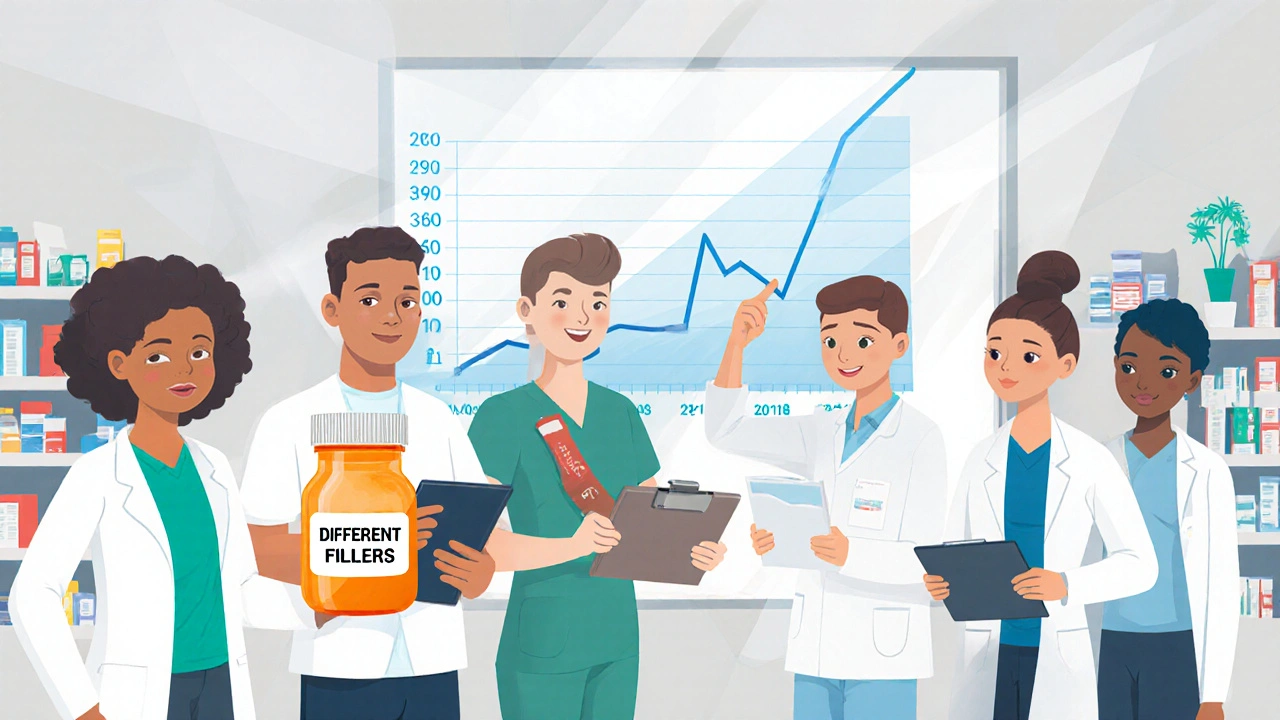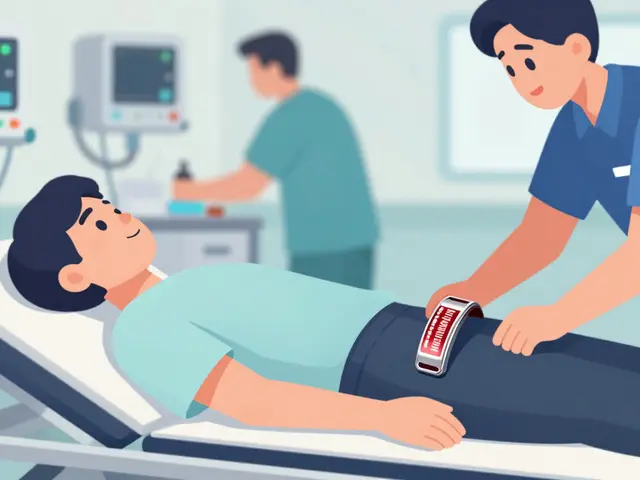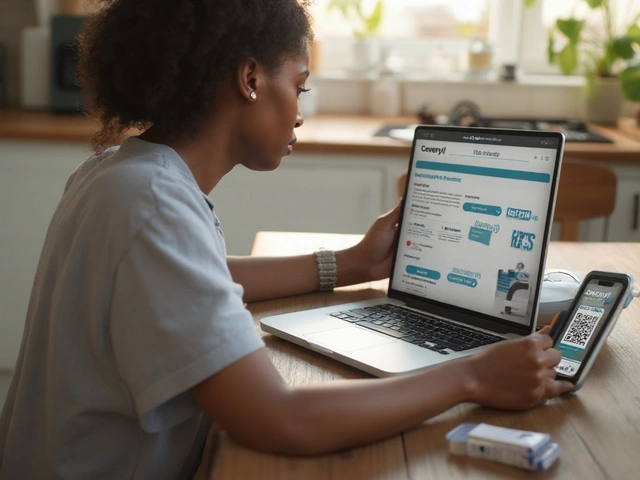
When a patient picks up a generic version of their blood pressure pill and suddenly feels dizzy, nauseous, or develops a rash they’ve never had before - who do they call? More often than not, it’s the pharmacist. That’s because pharmacists are on the front lines of drug safety, especially when it comes to generic medications. But here’s the problem: most adverse reactions never get reported. And when they don’t, no one notices the pattern - until someone gets seriously hurt.
Why Generic Medications Are a Hidden Risk
People assume generics are just cheaper versions of brand-name drugs. And technically, they are. But "therapeutic equivalence" doesn’t mean identical. The active ingredient must match in strength and dosage. But what about the fillers? The dyes? The coating? Those aren’t regulated the same way. And those small differences can trigger reactions in sensitive patients. A 2022 study in the Journal of the American Pharmacists Association found that 1 in 5 patients switching to a generic version reported new or worsening side effects. Not all of them were serious. But many were unexpected - and none of them were tracked. Why? Because pharmacists, despite being the most accessible healthcare professionals, often don’t report these events. The FDA’s FAERS database has over 24 million reports since 1968. But experts estimate less than 1% of actual adverse events make it in. For generics, the number is likely even lower. Why? Because both patients and providers assume the drug is "the same" - so they don’t think to connect the dots.What Pharmacists Are Legally Required to Do
In some places, reporting isn’t optional - it’s law. In British Columbia, pharmacists are required by the Health Professions Act to report any suspected adverse drug reaction to Health Canada. They must also notify the prescriber and update the PharmaNet record. That’s not a suggestion. That’s a professional duty. New Jersey has similar rules for consultant pharmacists working in long-term care. They must document and report adverse events before the end of their shift. Other states don’t have the same written rules - but that doesn’t mean pharmacists are off the hook. The FDA doesn’t require healthcare providers to report adverse events. But they strongly urge it - especially for serious reactions: those that lead to hospitalization, disability, birth defects, or death. And here’s the key point: if a pharmacist suspects a generic drug caused the reaction, they have a responsibility to report it - even if they’re not sure. Why? Because one report might seem insignificant. But 10 reports? 50? That’s a signal. That’s how safety issues get caught early.The Real Barriers: Time, Training, and Confusion
A 2021 survey by the National Community Pharmacists Association found that 78% of pharmacists spend 15 to 30 minutes per adverse event report. In a busy pharmacy, that’s a lot of time. And most don’t get paid extra for it. Add to that the fact that 62% say they simply don’t have enough time during the workday - and you’ve got a system that’s set up to fail. Then there’s confusion. Many pharmacists don’t know how to tell the difference between a known side effect and a true adverse reaction. For example, fatigue from a statin? That’s common. But sudden muscle weakness two weeks after switching to a new generic version? That’s not normal. That’s a red flag. The British Columbia Pharmacists Association calls lack of awareness one of the biggest reasons for under-reporting. Many pharmacists weren’t trained to recognize or document these events. They were taught how to dispense - not how to investigate.How to Report an Adverse Event - Step by Step
You don’t need a PhD to report. Here’s how to do it right:- Recognize the signal. Did the patient report a new symptom after switching to a generic? Did the reaction start after a recent dose change? Is it inconsistent with the drug’s known profile?
- Document everything. Write down the patient’s name (or ID if privacy allows), the drug name (brand and generic), dose, start date, reaction details, onset time, and any other medications they’re taking.
- Talk to the patient. Ask: "Have you noticed this before?" "Did you switch brands recently?" "Did you take any new supplements?" These details matter.
- Report to the right place. In the U.S., use MedWatch Online (FDA’s portal). In Canada, use Health Canada’s online form. In Australia, use the TGA’s database. Don’t wait for the manufacturer to report it - you’re the first line of defense.
- Follow up. If the patient comes back with the same issue on a different generic, document it again. Patterns emerge over time.
Why Your Report Matters - Even If It’s "Just One"
Think your report won’t make a difference? Look at what happened in Europe. In 2012, the European Medicines Agency made adverse event reporting mandatory for all healthcare professionals. Within two years, reporting rates jumped by 220%. That’s not luck. That’s policy change. In the U.S., states like British Columbia are leading the way. By 2025, industry analysts predict 75% of U.S. states will adopt similar mandatory reporting rules for pharmacists. Why? Because data proves it works. A 2022 study showed pharmacist-led reporting increased documentation by 37% in community pharmacies. And here’s the quiet truth: generics are the backbone of modern healthcare. They save billions. But they also carry hidden risks. If pharmacists don’t report, manufacturers won’t know. Regulators won’t act. Patients will keep getting hurt.
What’s Changing - And What’s Coming
Technology is helping. The FDA’s MedWatch Online system now handles 43% of healthcare professional reports - up from 29% in 2020. The National Association of Boards of Pharmacy has partnered with 32 state boards to build reporting tools directly into pharmacy software. In pilot programs in California and Texas, reporting time dropped by 40%. The FDA’s Sentinel Initiative is now pulling data from community pharmacies to monitor drug safety in real time. That means your report could help flag a dangerous batch before it reaches other patients. The message is clear: pharmacists aren’t just dispensers. We’re safety monitors. And when it comes to generics - where assumptions are dangerous - our role is more critical than ever.What You Can Do Today
- If you’re a pharmacist: Make a habit of asking patients if they’ve noticed changes since switching to a generic. Write it down. Report it. Even if it’s small.Are pharmacists legally required to report adverse drug reactions?
It depends on where you practice. In British Columbia, Canada, pharmacists are legally required to report adverse drug reactions to Health Canada under the Health Professions Act. In New Jersey, consultant pharmacists must report to the Adverse Event Reporting System. In most U.S. states, reporting is not mandatory by law, but the FDA strongly encourages it - especially for serious reactions. Even without a legal mandate, professional ethics and patient safety standards make reporting a core responsibility.
Why are adverse events under-reported for generic medications?
Many assume generics are identical to brand-name drugs, so any side effect is dismissed as expected. Patients often don’t realize they switched medications. Pharmacists may not know how to identify a true adverse reaction versus a common side effect. Time constraints and lack of training also play a major role. Health Canada estimates only 5-10% of all adverse reactions are reported - and the rate is likely lower for generics.
What information should I include in an adverse event report?
Include: the patient’s age and gender (if permitted), the drug name (brand and generic), dose, route, start date, description of the reaction, when it started, severity, duration, any other medications or supplements taken, and whether the reaction improved after stopping the drug. Also note if the patient had a similar reaction to another generic version. Details matter - they help identify patterns.
How long does it take to report an adverse event?
It typically takes 15 to 30 minutes, according to a 2021 National Community Pharmacists Association survey. That includes gathering patient information, documenting the reaction, and submitting the report. New tools integrated into pharmacy software are cutting that time by up to 40%, making it easier to report without disrupting workflow.
Can I report an adverse event if I’m not 100% sure it was caused by the drug?
Yes - and you should. The FDA and Health Canada encourage reporting even when causation is uncertain. Adverse event databases rely on suspicion, not proof. If a patient had a new reaction after starting a new generic, and no other clear cause exists, report it. One report might not change anything. But 10 reports on the same generic? That’s how safety alerts get triggered.
What’s the difference between an adverse drug reaction and a side effect?
A side effect is a known, expected, and often mild reaction listed in the drug’s labeling - like drowsiness from antihistamines. An adverse drug reaction is an unexpected, harmful, and unintended effect that wasn’t documented or is more severe than expected. For example, sudden kidney failure after switching to a new generic version of a blood pressure drug - even if it’s "the same" - is an adverse reaction, not just a side effect.
How can I get training on adverse event reporting?
Many pharmacy associations offer free online modules. The American Society of Health-System Pharmacists (ASHP) has guidelines and training resources. The FDA’s MedWatch website includes educational materials for healthcare professionals. Check with your state or provincial pharmacy association - many now offer continuing education credits for ADR reporting training. Don’t wait for a crisis to learn.




Neoma Geoghegan
November 24, 2025 AT 05:45Pharmacists are the unsung heroes of drug safety. If we don't report, no one will. One report might seem tiny but multiply that by 500 pharmacies? That's how you catch a bad batch before it kills someone.
Just ask the patient. Write it down. Submit it. Done.
Nikki C
November 25, 2025 AT 06:11I used to think generics were all the same until my mom started getting migraines after switching to the cheap version of her thyroid med. Turned out the filler had gluten. She’s celiac. No one asked. No one tracked it. Now I make sure every pharmacist I deal with knows to ask about switches. It’s not just about cost-it’s about what’s in the pill you didn’t know was different.
Alex Dubrovin
November 26, 2025 AT 18:34Man I hate reporting. Takes forever. My manager says do it but we’re slammed 10 hours straight. Still I do it. One time I reported a rash from a new generic lisinopril. Two weeks later another patient came in with the same thing. Same batch. We flagged it. FDA pulled it. That’s why I keep doing it even when I’m tired.
Jacob McConaghy
November 27, 2025 AT 21:38Let’s be real-this isn’t about law or policy. It’s about culture. We train pharmacists to dispense, not to investigate. We don’t reward reporting. We punish it with extra time. So of course people skip it. Change the system, not the guilt. Pay us for reporting. Build it into the workflow. Make it easy. Then watch the numbers climb. Simple.
Natashia Luu
November 28, 2025 AT 00:09It is unconscionable that pharmacists are not uniformly mandated to report adverse drug reactions across all jurisdictions. The absence of a federal requirement constitutes a systemic failure of public health governance. Patients are being exposed to preventable harm due to bureaucratic negligence and professional apathy. This is not a suggestion-it is a moral imperative that must be codified with teeth.
akhilesh jha
November 29, 2025 AT 19:05Interesting. In India, generics are the only option for most. But no one reports. Why? Because patients think side effects are normal. Doctors don’t care. Pharmacies don’t record. I worked in a rural pharmacy once. A woman came back with swelling after switching to a new metformin. I asked her if she switched brands. She said yes. I wrote it down on a sticky note. No one ever followed up. I wonder if anyone ever saw that note.
Jeff Hicken
November 30, 2025 AT 04:47why do we even bother? the fda gets like 5 million reports a year and nothing ever happens. i reported a weird reaction to a generic omeprazole last year. no call no email no nothing. just deleted into the void. save your time. if your drug kills you, at least you died trying to be responsible.
Vineeta Puri
December 1, 2025 AT 20:02As a pharmacist with over 18 years in community practice, I can attest that the barriers to reporting are real-but not insurmountable. The key is institutional support. When my pharmacy implemented a one-click reporting template linked to our dispensing system, our reporting rate increased by 300% in six months. Training matters. Systems matter. Leadership matters. We must stop treating reporting as an add-on and recognize it as a core clinical function. Patients deserve nothing less.
Victoria Stanley
December 3, 2025 AT 07:49Just had a patient today come in saying her new generic metoprolol made her feel like she was underwater. Asked if she switched brands-she did. Same script, different pill. I documented everything, called the prescriber, and filed the MedWatch form. She said thank you like I’d saved her life. And honestly? I kind of did. These little moments are why we do this. Don’t wait for a law. Do it because it’s right.